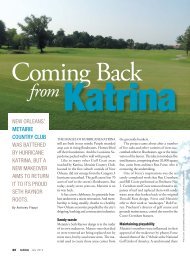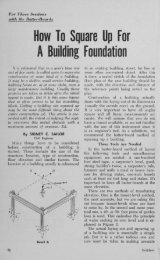Kroydon demand on the Upswing « KROYDON
Kroydon demand on the Upswing « KROYDON
Kroydon demand on the Upswing « KROYDON
You also want an ePaper? Increase the reach of your titles
YUMPU automatically turns print PDFs into web optimized ePapers that Google loves.
Maintenance Changes from<br />
Art to Art and Science<br />
Greenkeeping 25 years ago was an art.<br />
Now it's an art and a science. It required<br />
just as much work 25 years ago as it does<br />
now, despite <strong>the</strong> extensive use of power<br />
equipment today.<br />
Although things have changed in <strong>the</strong><br />
supervisi<strong>on</strong> of greenkeeping, <strong>the</strong>re are<br />
more headaches. More specialists have<br />
had to be discovered and developed, more<br />
super-fine grasses have had to be produced<br />
to satisfy <strong>the</strong> <str<strong>on</strong>g>demand</str<strong>on</strong>g> of always<br />
something better wanted by <strong>the</strong> golfer<br />
who knows very little about what goes <strong>on</strong><br />
in course maintenance and why <strong>the</strong> greens<br />
may not be up to his expectati<strong>on</strong>s. We<br />
have left a good many things behind —<br />
things that are old today, but which<br />
would be new to <strong>the</strong> present day golfer if<br />
cultivated and put back into <strong>the</strong> golf<br />
course for putting greens.<br />
It was my experience that a fine new<br />
Zealand Chewings fescue putting green<br />
had about as fine a surface or surface<br />
texture to c<strong>on</strong>trol <strong>the</strong> speed of <strong>the</strong> ball as<br />
it is being stroked for <strong>the</strong> cup as you<br />
could find. I have seen some excellent<br />
greens of this fescue and had charge of<br />
some greens at a club in <strong>the</strong> Chicago district<br />
that had some of <strong>the</strong>se fine texture<br />
greens years ago, but, in golf, like everywhere<br />
else, we strive to get better things<br />
so <strong>the</strong> fescue greens went out for <strong>the</strong> bent<br />
greens which replaced <strong>the</strong>m.<br />
If you make <strong>on</strong>e mistake as far as<br />
greens are c<strong>on</strong>cerned, you may have a setback<br />
as far as good greens are c<strong>on</strong>cerned<br />
for m<strong>on</strong>ths, especially in mid-seas<strong>on</strong>. Generally<br />
today if you lose a bent green in<br />
July, it is out for <strong>the</strong> balance of <strong>the</strong> seas<strong>on</strong>,<br />
but <strong>the</strong> fescue green had its drawbacks<br />
too.<br />
Watering Problem Changes<br />
The fescue greens could stand <strong>the</strong> hot<br />
and humid wea<strong>the</strong>r better, and were not<br />
so apt to burn out. You never heard of<br />
tight spots such as you find in bent<br />
greens today. So what do you do? You<br />
now have to aerate a green to get <strong>the</strong><br />
water down into <strong>the</strong> tight spots, but you<br />
are not bo<strong>the</strong>red with angle worms, as<br />
you were with a fescue green, because <strong>the</strong><br />
worms d<strong>on</strong>'t seem to get through tightlywoven<br />
bent greens. The worms took care<br />
of aerati<strong>on</strong> of <strong>the</strong> fescue greens. Therefore<br />
<strong>the</strong> fescue green didn't get baked out<br />
or hard as some of our present day bent<br />
greens unless <strong>the</strong>y're mechanically aerated.<br />
By HANK MILLER<br />
Supt., Briergate Golf Club, Deerfield, III.<br />
The old style flat or square green, which<br />
most of <strong>the</strong> old courses had 25 or 30<br />
years ago, were easy to sprinkle uniformly<br />
without flooding out <strong>the</strong> middle,<br />
and some greens had very little drain tile<br />
in <strong>the</strong>m to carry off <strong>the</strong> excess water. As<br />
it was, <strong>the</strong> water went straight down into<br />
<strong>the</strong> green and could not run off and leave<br />
<strong>the</strong> high spots dry as is often <strong>the</strong> case<br />
today.<br />
The undulating greens being built today<br />
in place of <strong>the</strong> old-style flat greens make<br />
watering more of a watchful job for <strong>the</strong><br />
night man who sprinkles greens. He must<br />
be sure not to drown out <strong>the</strong> middle of<br />
<strong>the</strong> green in trying to get water <strong>on</strong> <strong>the</strong><br />
outside elevati<strong>on</strong>s. Once a green has been<br />
drowned out in <strong>the</strong> middle you can expect<br />
trouble, and if it frequently gets drowned<br />
out, you can rest assured that your green,<br />
especially when it's hot <strong>the</strong> next day, will<br />
get diseased.<br />
We have many kinds of grass diseases I<br />
believe are mainly caused by over-watering.<br />
If <strong>the</strong>y are not treated with chemicals<br />
and <strong>the</strong> water kept off, you will find<br />
your bent green will just melt away.<br />
Some of our architects went to extremes<br />
in years g<strong>on</strong>e by as <strong>the</strong>y neglected<br />
<strong>the</strong> maintenance job. Building a green<br />
and maintaining it were two different<br />
things.<br />
You see greens with such abrupt c<strong>on</strong>tours,<br />
that <strong>the</strong>y are hard to water and<br />
hard to mow without scalping <strong>the</strong>m in<br />
places. An architect built a green and left<br />
it to <strong>the</strong> superintendent who had to take<br />
care of it as his job, even though it<br />
might be a difficult and expensive problem<br />
to keep fine turf <strong>on</strong> <strong>the</strong> green. Yet, from<br />
an architectural standpoint, this might<br />
be a beautiful green to look at.<br />
A trend in c<strong>on</strong>structi<strong>on</strong> has been to<br />
"hang <strong>the</strong> green up <strong>the</strong>re" with traps that<br />
also hang. The green may look like a<br />
perfect picture <strong>on</strong> <strong>the</strong> horiz<strong>on</strong> and provide<br />
an interesting shot but it is a c<strong>on</strong>stant job<br />
for <strong>the</strong> superintendent to maintain such a<br />
masterpiece from spring to fall, from daylight<br />
to dawn. Every day has a new<br />
problem for <strong>the</strong> superintendent and some<br />
days are tough <strong>on</strong>es too!<br />
Experts can bang shots into <strong>the</strong>se elevated<br />
c<strong>on</strong>toured greens with c<strong>on</strong>fidence<br />
that <strong>the</strong>y will surely stop, unless, of<br />
course, <strong>the</strong> green is hard. Compare that<br />
to <strong>the</strong> old flat green where <strong>the</strong> same golf

















